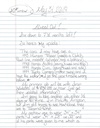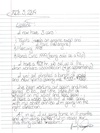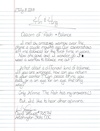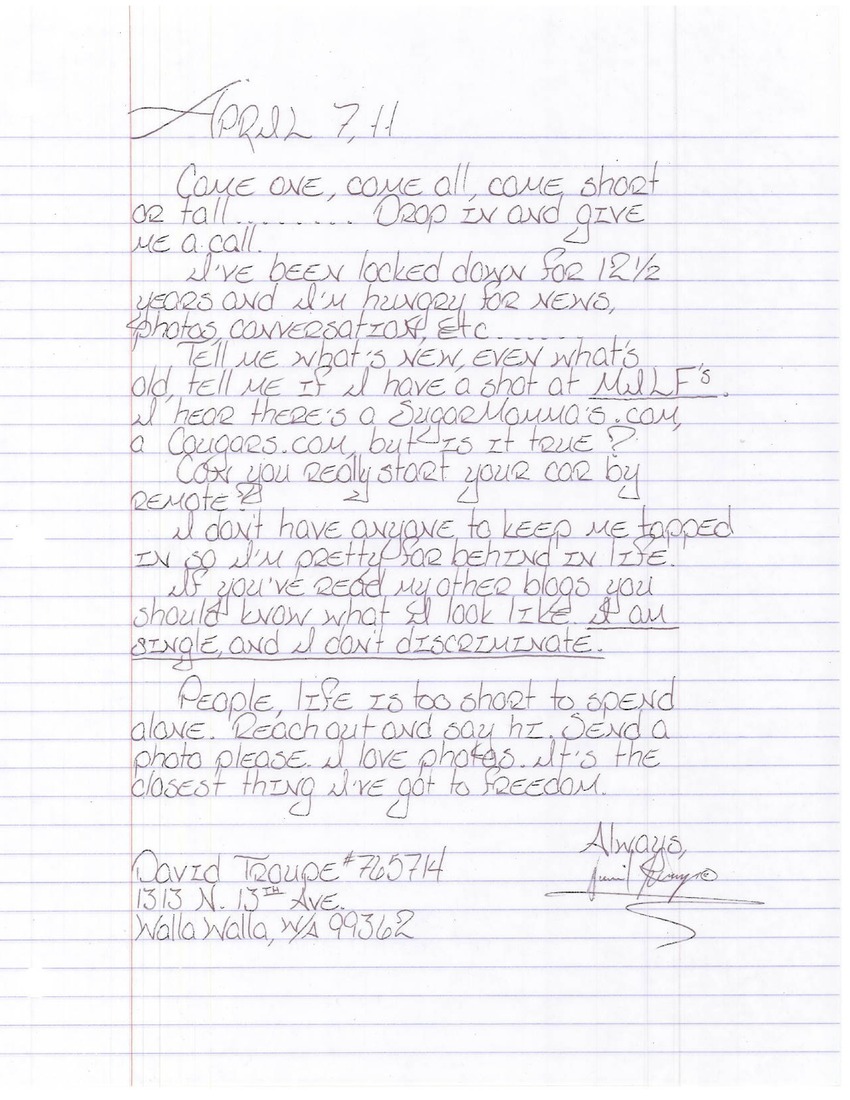
Transcription
[Drawing of a heart with wings.]
April 7, 2011
Come one, come all, come short or tall. Drop in and give me a call.
I've been locked down for 12 1/2 years, and I'm hungry for news, photos, conversations, etc. Tell me what's new, even what's old. Tell me if I have a shot at MILFs. I hear there's a sugarmammas.com, a cougars.com. But is it true?
Can you really start your car by remote?
I don't have anyone to keep me tapped in so I'm pretty for behind in life. If you've read my other blog posts, you should know what I look like. I am single, and I don't discriminate.
People, life is too short to spend alone. Reach out and say hi. Send a photo please. I love photos. It's the closest thing I've got to freedom.
Always,
[signature]
David Troupe #765714
1313 N. 13 Ave.
Wallawalla, WA 99362
---
"Through loneliness comes the
self we never knew
Through fear comes the first
step in understanding ourself."
—David Troupe
Other posts by this author
|
2019 jun 11

|
2019 feb 12

|
2018 jul 17

|
2018 jun 30

|
2018 jun 30

|
2018 jun 30

|
More... |




Replies (19)
LEXINGTON, N.C. — Do you have change for a million-dollar bill?
Police say a North Carolina man insisted his million-dollar note was real when he was buying $476 worth of items at a Walmart.
Investigators told the Winston-Salem Journal that 53-year-old Michael Fuller tried to buy a vacuum cleaner, a microwave oven and other items. Store employees called police after his insistence that the bill was legit, and Fuller was arrested.
The largest bill in circulation is $100. The government stopped making bills of up to $10,000 in 1969.
Fuller was charged with attempting to obtain property by false pretense and uttering a forged instrument. He is in jail on a $17,500 bond, and it isn't clear if he has an attorney. He is scheduled to be in court Tuesday.
The killer documented his attack with a Polaroid camera. The female victim blacked out, but was startled awake by the bright flash of the camera. On July 7, 2010, the Los Angeles Times reported that an arrest had been made in the Grim Sleeper case. The suspect is Lonnie David Franklin Jr., who is 57 years old. Originally, the police had not been able to obtain a DNA match between evidence found at the crime scenes and people in California’s DNA profile database. However, officials located similar DNA belonging to Lonnie Franklin’s son, Christopher, who was convicted of a felony weapons charge. Ultimately, the police used a piece of discarded pizza with Lonnie Franklin’s DNA to make the link.
In order to obtain the evidence, a federal detective pretended to be a waiter at a restaurant where the suspect ate. He collected dishes, silverware, glasses, and pizza crusts to obtain DNA. Saliva found on the victim’s breasts was used to obtain a DNA match linking Lonnie Franklin to the murders. Along with the DNA evidence, the police discovered a large collection of circumstantial evidence against Franklin when searching his home. On December 16, 2010, the Los Angeles Police Department released 180 photos of women found in Franklin’s home. Officials released the images after unsuccessful attempts to identify the people, who are possibly additional victims.
In all, investigators found over 1,000 photos and several hundred hours of video in Franklin’s home. The images show mainly African American women of a wide age range, from teenagers to middle-aged and older, often nude. Police believe Franklin took many of the pictures, which show both conscious and unconscious individuals, and date back up to 30 years. As the history of serial killers has taught us, the number of linked murders to a specific DNA specimen does not indicate the entire murder count. The photographs suggest that Franklin may have killed hundreds of unidentified women.
#8: Eyjafjallajökull is one of Iceland’s smaller ice caps, located in the far south of the island. It is situated to the north of Skógar and to the west of the larger ice cap, Mýrdalsjökull. Eyjafjallajökull covers the caldera of a volcano, with a summit elevation of 1,666 meters (5,466 ft). The volcano has erupted relatively frequently since the last ice age. Before 2010, the most recent major event was in 1920. The 2010 Eyjafjallajökull eruptions weren’t the largest ever recorded, but the subsequent ash clouds that were released caused an enormous disruption to air travel across western and northern Europe over a six day period in April 2010. It was the highest level of air travel disruption since the Second World War.
The most severe explosion occurred on April 14, 2010, and resulted in an estimated 250 million cubic meters (330,000,000 cu yd) of ejected tephra. The ash plume rose to a height of approximately 9 kilometers (30,000 ft). The subsequent air traffic closures caused millions of passengers to be stranded, not only in Europe, but across the world. Between the months of April and May, 2010, various regions, including Ireland, Scotland, the United Kingdom, Spain, Portugal, northern Italy and Austria, had to completely close their airspace. The volcano was able to inject its ash plume directly into the jet stream. The ash was then carried over Europe into some of the busiest airspace in the world.
Contrary to what many believe, the infestations were often reported in clean, upscale hotels. The 2010 outbreak caused the first-ever bedbug summit in Chicago, where experts convened to discuss the invasion. The tiny bugs are not only hard to get rid of, but their expansion is all but impossible to prevent. A few tiny bugs clinging to a piece of clothing can lead to an infestation of not just your bed, but your sofa, your closet and your carpets. A number of health effects can occur due to bedbugs, including skin rashes, psychological effects and allergic symptoms.
To make the situation worse, recent tests have determined that the insects responsible for the 2010 outbreak have undergone a genetic restructuring. The new bedbugs have developed immunity to many chemicals. They also have a better ability to protect nerve cells and thicker shells. All of this research has determined that we are being confronted with an entirely different species of insect. Bedbug infestations across North America haven’t spared London, where the city-run public housing agency’s pest-control budget has increased 10-fold for 2011. Officials are trying to find an effective way to track and kill the bedbug populations. Some of these methods include bedbug-sniffing dogs and a wide range of treatments that involve both extreme heat and cold.
To find the miners, rescuers used percussion drills to make eight exploratory boreholes about 15 centimeters (5.9 in) wide. The effort was complicated by out-of-date maps of the mine shafts. While underground, the crew’s supervisor, Luis Urzúa, helped organize the workers meager resources. The men gathered in a secure room called a “refuge.” On August 22, the eighth borehole broke through a ramp, located 688 meters (2,257 ft) underground. Approximately 20 meters (66 ft) from an emergency shelter room where the miners were staying. The crew heard the drills approaching for days and prepared notes which they attached to the tip of the drill. The engineers thought they heard tapping on the drill tip, but were surprised to discover the notes, as the miners had survived for 17 days, which was much longer than expected.
The note read “We are alright in the shelter, the 33 [of us].” The words became an emblem of the miners’ survival and the rescue effort, appearing on websites, banners and t-shirts. Video cameras were soon sent down the borehole capturing the first grainy, black-and-white, silent images of the skinny, dirty, shirtless and unshaven men. The miners survived underground for a record 69 days. All 33 people were rescued and brought to the surface on October 13, 2010. After the last trapped miner was winched to the surface, the rescue workers held up a sign stating “Mission accomplished Chile” to the estimated more than 1 billion people watching on live television around the world. The event was one of the most watched programs of the 21st century.
The WikiLeaks website began to gain mainstream recognition when they released a video showing an American airstrike that occurred on July 12, 2007 in Baghdad, which still remains on the website. The classified U.S. military footage shows a series of attacks by a U.S. helicopter that killed 12 people, including two news staff, Saeed Chmagh and Namir Noor-Eldeen. After gaining military clearance, the helicopter fired a series of 30 mm calibre cannon shells into a group of ten men alleged by the U.S. Army to be Iraqi insurgents. In fact, the American soldiers had mistaken a collection of cameras for guns. The video is extremely graphic, especially the initial shooting when a group of people are instantly killed.
The second airstrike, using 30 mm fire, was directed at a man who pulled up in a van and attempted to help the wounded. In the third airstrike, the “Bush” helicopter team deployed three AGM-114 Hellfire missiles, which destroyed a building. An undisclosed number of civilians were killed in the explosion. It was the first time that the American public had been exposed to such a war video. After WikiLeaks released a series of logs surrounding the Iraqi War, the Pentagon referred to the exposure as “the largest leak of classified documents in its history.” Media coverage of the documents focused on claims that the U.S. government ignored reports of torture by the Iraqi authorities.
In October 2010, Assange told a leading Moscow newspaper that “The Kremlin had better brace itself for a coming wave of WikiLeaks disclosures about Russia.” In 2010, Assange told Forbes magazine that WikiLeaks was planning another “megaleak” for early in 2011, which would be from inside the private sector and involve “a big U.S. bank.” Following the announcement, Bank of America’s stock price fell by 3%. During the interview, Assange commented on the possible impact of the leak. “It could take down a bank or two.” In December 2010, Julian Assange’s lawyer, Mark Stephens, told The Andrew Marr Show on the BBC, that WikiLeaks had information that it considers to be a “thermo-nuclear device” which it would release if the organization needs to defend itself.
Due to the Bayer process, the red mud is highly basic with a pH ranging from 10 to 13. During the 2010 Ajka accident, the red mud was released as a 1–2 m (3–7 ft) wave, flooding several nearby localities, including the village of Kolontár and the town of Devecser. The high pH levels of the mud caused severe chemical burns to humans and animals, killing life in rivers and contaminating soil. At least nine people died and 122 people were injured. The chemicals extinguished all life in the 100 km (62 mi) long Marcal River.
On October 7, 2010, the red mud reached the Danube River, prompting countries, such as Slovakia, Croatia, Serbia, Romania, Bulgaria and Ukraine to develop emergency plans in response. The Danube is Europe’s second longest river. It is notable for being classified as an international waterway. On October 11, the Hungarian government announced that the managing director of the company involved with the disaster had been arrested, to be charged with “criminal negligence leading to a public catastrophe.” After the spill, emergency teams began pouring plaster and acetic acid (vinegar) into the Raba-Danube meeting point to lower the pH value.
After a government inquest, the Hungarian Prime Minister Viktor Orbán released a statement that indicated the cause of the spill was, presumably, human error. The Hungarian government has also said that the mud is “not poisonous” to humans. It has been suggested that the heavy metal concentrations are not continuing to impact the environment. On the hierarchy of industrial wastes, red mud is not as toxic as most. However, recent studies of the soil have indicated that a high level of salt in the ground is negatively impacting plant life. The ecological disaster remains one of the worst in the history of Hungary. Following the accident, a second dam was build directly behind the original to prevent the weakened wall from a complete failure.
The U.S. Geological Service’s website has listed 90 mass deaths of birds and other wildlife from June through December 12, 2010. On December 29, 2010, 100,000 freshwater drum were found dead across 17 miles (27 km) of the Arkansas River bank. The fish were reported along the Ozark Lock and Dam downstream to River Mile 240, directly south of Hartman, Arkansas. The exact cause of the mass death is yet to be determined, however, state officials have suggested that a disease may be at fault. Residents have been advised not to eat the fish.
In research on the Arkansas River incident, it has been noted that earthquakes may be a contributing factor. In 2009, the state of Arkansas registered 38 earthquakes. Since September 20, 2010, the area around Guy, Arkansas, has been plagued by more than 500 earthquakes. The temblors, ranging from 1.8 to 4.0, have been described as abnormal for this area. Beginning in early 2011, the string of unexplained animal deaths began to be referred to in the media as the “aflockalypse,” provoking comparisons to a cataclysmic event such as the apocalypse.
On New Year’s Eve, 2010 more than 5,000 dead red-winged blackbirds and starlings were found in Beebe, Arkansas, USA. The incident has been attributed to mass collisions and stress caused by fireworks. On December 30th, three young whooping cranes and hundreds of grackles, cowbirds, starlings and red-winged blackbirds died in Kentucky. The cranes were first seen flying low and crashing into objects in the streets. It appears that in many of the various descriptions of bird fatalities, the animals are becoming confused and running themselves into poles, signs, buildings and other objects.
A high intensity of rainfall between January 12 and 14, 2011, caused major flooding across much of the western and central parts of the Australian state of Victoria. The question has been raised. When will the rain stop? Queensland Treasurer Andrew Fraser said it is not possible to put a figure on the damage, but a rough estimate is currently putting lost revenue from Australia’s GDP at about A$30 billion. The floods damaged a large portion of Australia’s coal mines and cotton plantings, among other resources. The 2010 La Niña weather pattern, which brings wetter conditions to eastern Australia, was the strongest since 1973.
Record or near to record sea surface temperatures were recorded off the Queensland coast in late 2010. The month of December, 2010, was Queensland’s wettest on record. 2010 was the Australian continent’s third wettest year ever. Communities isolated by floodwaters have experienced food shortages, and a rise in the cost of fruits and vegetables. On January 11, the Wivenhoe Dam in South East Queensland filled to a level equivalent to 191% of its supply capacity. The dam can hold the equivalent of 225% of its supply capacity. As of January 14, 2011, 30 deaths have been attributed to the Australian floods, 15 of which are from the Toowoomba and the Lockyer Valley area. Additionally, 14 people are listed as missing.
Starting on January 11, 2011, a series of floods and mudslides struck the Mountainous Region in the Brazilian state of Rio de Janeiro. The floods have caused at least 763 deaths so far, including 367 in the Nova Friburgo area and 310 in the city of Teresópolis. In a 24-hour period between January 11 and 12, 2011, this area of Brazil registered more rainfall than was expected for the entire month. Following the downpour, many areas in the region flooded. The disaster caused widespread property damage. Around 2960 people had their homes destroyed. The Brazilian local media has claimed that the combination of floods, mudslides and landslides in Rio de Janeiro has become the worst weather-related natural disaster in the country’s history. However, a similar flooding event occurred in 1967 when 1,700 people lost their lives.
By late November 2010, 320 miles (510 km) of the Louisiana shoreline was closed because of the spill. In January 2011, eight months after the explosion, an oil spill commissioner reported that tar balls continue to wash ashore, wetlands are fouled and dying, and crude oil remains visible off the Gulf of Mexico coastlines. Scientists have reported immense underwater plumes of dissolved oil not visible on the surface, as well as an 80-square-mile (210 km) “kill zone” surrounding the damaged BP well, where it looks like everything is dead on the seafloor. The disaster has put hundreds of endangered animal species at risk.
The North Atlantic Bluefin Tuna, prized for sushi and sashimi, regularly travels across the Atlantic seaboard to spawn in the Gulf of Mexico. Five of the world’s seven sea turtle species live, migrate and breed in the Gulf region. Kemp’s ridley is the world’s most endangered species of sea turtle. Ten days after the accident, scientists recorded 156 sea turtle deaths, most of the victims were Kemp’s ridleys. The grass beds south of the Chandeleur Islands are very close to the oil spill. These grasses are a nursing area for a large number of shark species. Oil spills pose an immediate threat to marine mammals because they need to surface and breathe. Some other notable creatures at risk are Louisiana oysters, shrimp, blue crab, and a huge collection of birds, including the Brown Pelican.
BP didn’t want people to see the oil collecting on the surface of the water, so they made the premature decision to use the dispersants. A dispersant was used in an attempt to clean up the Exxon Valdez oil spill of 1989. During that spill, fisheries didn’t see a dramatic decline in business right away. However, four years after the disaster, the herring market made a strong decline. Since that time, there has been a steady downward trend of the salmon fisheries in the area where the Exxon Valdez spill occurred, which is Prince William Sound, Alaska. This has concerned environmentalists who have predicted that the damage caused by the Deepwater Horizon oil spill is only beginning to impact the world economy and sea life.
Info copied from listverse.com
1) Walk through X-ray airport scanners — Who can forget the classic scene in Total Recall where Ahnuld walks through the scanner at the space port and we get a full x-ray of his body? Well, for some reason, people didn’t think this technology was quite as cool when it was brought to an airport security line near them this year. Maybe it was the the thought that someone in a dark room is looking at virtual nudie pictures of us. Maybe it was the increase in radiation bombarding our bodies. Whatever it was, many want to leave this advance behind in 2010.
3) Alien Life — Admittedly it was not extra-terrestrial alien life, but a complex life form completely unlike our own was discovered this year. Rather than being carbon-based like us (and every other form of life we’ve known so far) this small microbial life form thrives on arsenic. This is a far cry from pointy eared Vulcans or acid drooling bugs, but it means that life seems to have developed twice on one planet greatly increasing the likelihood of ETs.
5) Big Brother — I remember as a young lad reading George Orwell’s masterwork, 1984, with great fear, but being highly skeptical of the entire concept that the government could spy on all of the people all of the time. That would take an awful lot of people watching. The answer, of course, is to have everybody watching everybody. It may not be exactly what Mr. Orwell predicted, but we are all watching each other these days using the Internet. Whether it’s an old lady in the UK throwing cats into trashcans or the broken condoms of Wikileaks founder Julian Assange, we are all now up in each others’ business to an unprecedented degree. And these people are all publicly taken to their own virtual Room 101 to repent their actions.
7)A Permanent Space Station — Although started in 1998 and not slated for final completion until 2011, 2010 was the first year in which the International Space Station (ISS) was fully crewed with 14 occupants. It may not be the double ringed floating Hilton envisioned in 2001: A Space Odyssey, but it still counts.
9)The Web — Yes, the Web has been around for 20 years now, but 2010 has seen the widespread deployment of some important new technologies that will fundamentally change the way you view the Internet’s most popular offspring. “Web 2.0″ was really just a marketing ploy compared to how HTML5, CSS3, and the new web typography are shaking things up. If you are using Firefox, Chrome, Safari, iOS devices or other tablet devices to view the Web, then you are getting a taste of things to come. Expect the static pages you are viewing now to come alive, transforming The New York Times into something more akin to the The Daily Prophet from Harry Potter.
I will post more later, love you! XOXO, Sissy